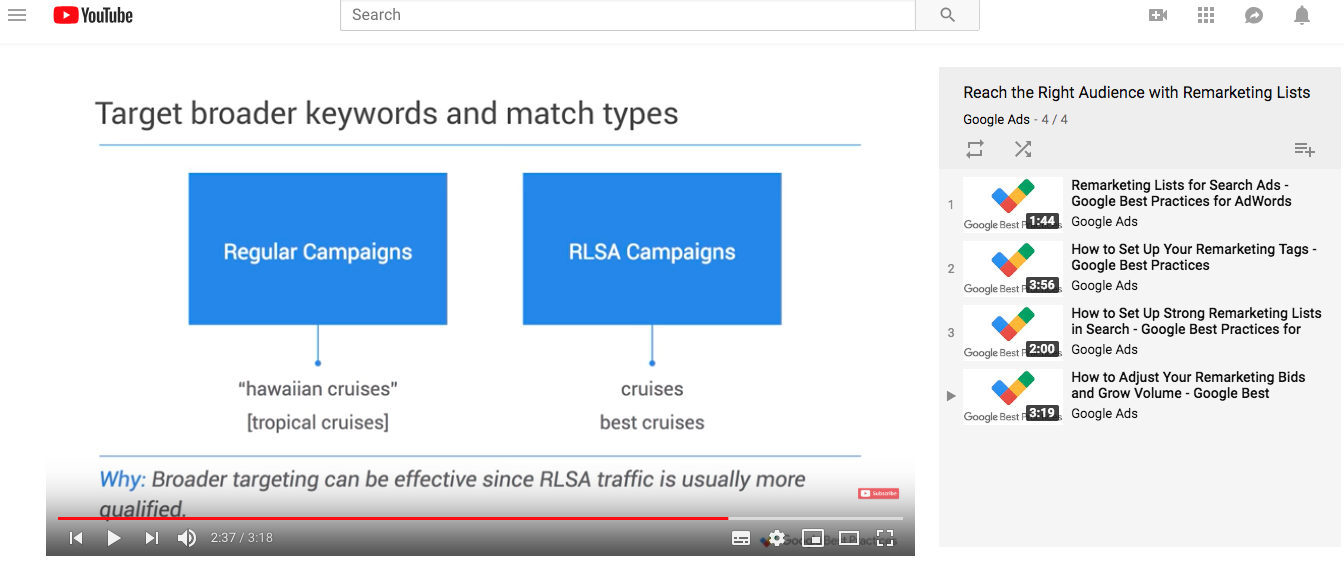How to Understand and Address Google Algorithm Updates
Google employees have recently announced that the upcoming Google Core Update is set to be released in the coming weeks. Understanding and addressing...
Read moreIn this latest article, Dr Dave Chaffey delves into the different solutions for audience targeting presented by Google, Facebook and LinkedIn.
In my last article, updating on Google's latest innovations I highlighted the growing popularity of audience targeting. According to Merkle in Q2 2018, 37% of Google search ad clicks were impacted
by Google’s specific audience targeting products. This rate was up from 21% of clicks a year earlier.
Given the importance of this trend, and the opportunity to increase reach and ROI, in this article, I'll explore in more depth the options in Google and also briefly look at equivalents in other advertising platforms like Facebook and LinkedIn.
It's likely that you're aware of Google's re-marketing lists, which are a way to reach a specific audience, in this case typically people who have interacted with your brand before, for example through a website visit. The reason I think it's worth taking another look at audience targeting is that there are now so many options to reduce ad wastage through closer targeting.
As Google explains, audience targeting simply allows you to be more accurate when choosing who sees your ads. In Google Ads Editor, you can download, view and assign existing audiences, including re-marketing lists, custom combination lists, life events, interest categories, affinity audiences and custom-intent audiences.
So, let's look at these options:
These are created by setting rules about when follow-up ads will be displayed. It's common to re-market to visitors who have shown intent by viewing a product or checkout page for example.
When re-marketing was first introduced it was fairly simple in that you could target broad groups of visitors, but it was time-consuming to create more relevant ads. These days, Google Ads is much more sophisticated, so for example, for different classes of business like Education, Flights, Hotels and rentals, Jobs, Retail, Property and Travel it automatically create lists for individual products to show more relevant creative to increase response. Mobile app users can also be re-targeted using re-marketing.
I find when training that RLSA are less well-known amongst marketers who generally know about the concept of re-marketing. RLSA are neat since they use the same re-marketing lists for ads that are served on the display network, but enable businesses to target more people while searching for related terms, thus expanding their reach. As Google explains there are two basic strategies for using re-marketing lists with search ads:
This video series explains the RLSA approach and best practices in more detail:

The level of insight available about your visitors has also increased, so for example, an outdoor clothing company might find the characteristics of their audience via the Google Ads audience insights report for their "All Converters" re-marketing list. They might discover that the people who typically convert on their website are: women, ages 25 to 44, outdoor enthusiasts, mostly use mobile devices and currently in the market for shoes. They could then decide to invest in a campaign with ads that target this audience profile, which should increase their ROI.
To learn more, read this article on demographic targeting from Wordstream. It explains how the new demographic targeting options can be found at the ad group level of Google Ads search campaigns.
From the “Audiences” tab, a new subtab named “Demographics” is available and shows the performance data of how different ages and genders perform in that ad group. Advertisers can use this data to either create bid adjustments for different demographics or can exclude certain aged users or genders from seeing their ads on the SERP. The article gives more examples of this targeting.
This follows a similar thinking to the outdoor company example of re-targeting. It helps you expand the reach of your best-performing ads and lists by targeting new users with similar characteristics to your site visitors. These are powered by machine learning, so you don't need to manually set up demographic targeting.
How does this work? Well, Google Ads look at browsing activity on Display Network sites over the last 30 days, and use this in addition to the content that the user is viewing to understand the shared interests and characteristics of the people in your re-marketing list.
This long-standing approach available since 2015 is simpler in one sense, but can be harder to implement and keep synced compared to using Similar audiences, which can work in a similar way by analysing people in your "converters" list. Here the idea is that when users are signed in to their Google account, they see your ads as they use Google Search, YouTube and Gmail.
With Customer match you upload a data file or programmatically transfer customer contact data via an API to Google's servers. based on either email addresses, phone numbers or house addresses. Clearly security of this process is important to protect privacy and some companies may decide to not use this approach or limit it to less sensitive information like zip codes or post codes. Similar audiences is clearly less high risk.
Hopefully you can see the power of these techniques to reduce wastage on advertising and improve ROI by targeting people who have a better affinity with your products. If so, consider options to use these techniques on other platforms.
Facebook and Instagram offer re-targeting (re-marketing is a Google-specific term) via installing the Facebook pixel on your site. Visitors can then be re-targeted in a similar way.
Twitter have a similar solution they call re-marketing with tailored audiences.
Facebook's solution for automatically re-targeting product browsers or abandoners are Dynamic ads.
Finally, LinkedIn has relatively recently launched re-targeting after some false-starts over the years. Website re-targeting from LinkedIn uses the LinkedIn Insight tag for re-targeting. It's also worth knowing about since it enables a feature called website demographics, where you can gain insight about the characteristics of LinkedIn users visiting your site (or specific site sections). This was introduced mid 2017, so is still relatively new.
If you'd like to discover more about the different, evolving ways in which you can target your audiences, get in touch with our Digital Paid Media team today.
More articles you might be interested in:

Google employees have recently announced that the upcoming Google Core Update is set to be released in the coming weeks. Understanding and addressing...
Read more.png)
Advertising via Google is constantly evolving, and new ways to showcase your brand and business offering are regularly being rolled out. The latest...
Read more.png)
The UK market has been waiting with bated breath for Google’s Vehicle Ads release – so where is the update? Learn more.
Read more
As Google turns 25, we’re taking a look back at our favourite Google moments. Which features have made the biggest impact on digital marketing on...
Read more.jpg)
Performance Max is one of the easiest ways to tackle the full Google network, but are you maximising results? Dr. Dave Chaffey explores. Read more.
Read more
Google's change in guidance could transform the way content is created in the future, but how does it affect SEO and content creators going forward?
Read more
Google are launching their own chatbot to strengthen their AI capabilities, but what is it, and why is it exciting for searchers and SEOs alike?
Read more
Welcome to the latest round-up of all things digital. This is where we look at the latest updates in the world of PPC, SEO, Content and International...
Read more